#pentode
Explore tagged Tumblr posts
Text
全段差動6F6GTpp
しばらくの間ずっと「超3化」されいていた全段差動6F6GTppですが、明日のミニオフにそなえて、正しい5極菅接続に戻しました。
超3化されていた時は、禁欲的なつまらない音だったけど、5結に戻したら結構ええやんか。
—–
by Tetsu Kimura
2000.10.15(Sun)全段差動お茶会ミニオフ前の掲示板記録より
(http://www.op316.com/tubes/myamp/off0015a.htm)
0 notes
Text
wrote this while i was talking to someone. enjoy this sludgy dad rock riff.
#my art#i was trying to tune up from drop d and i overshot real bad. landed on this flat f note. kind of badass#i normally do not play in pentode cause i thought it'd be too loud. it's actually manageable with my compressor on.#idk why but it has a really transparent volume knob...#the rat in pentode sounds craaaaazy good
0 notes
Text
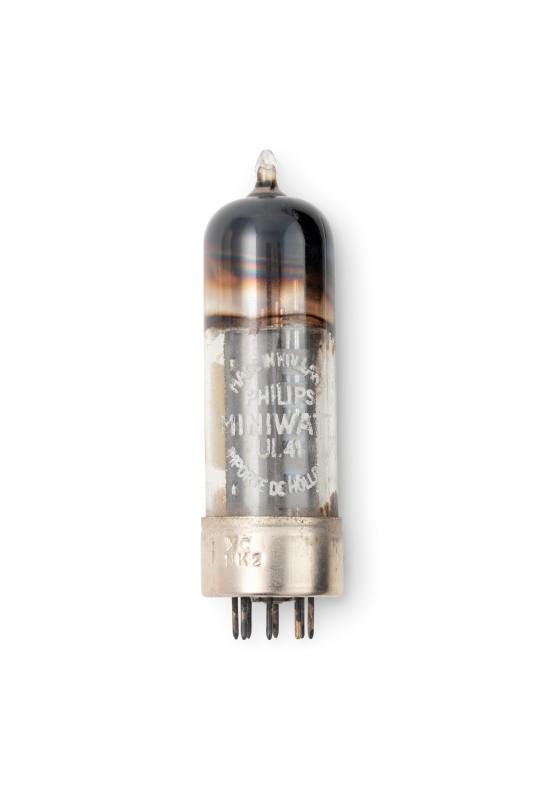
PHILIPS 'MINIWATT' TYPE UL41 ELECTRONIC VALVE
Electronic valve, 'Miniwatt', type UL41, remote cut off pentode, glass / metal, made by Philips, Holland, 1945
51 notes
·
View notes
Text
More info on Old Tube Stuff.
I found the company that makes an "updated" Harman Kardon Citation 2. They now call it the "Citation Sound -2". The marketing docs claim it is just like the old HK, but no it aint. Not even close. And they dont make it. A Chinese company called CAYIN is the builder. VAS is the importer to the US.
Funny a company that lies in its marketing.
https://vasnyinc.com/
I will not dispute if it has good quality components and all that. But it is evident it does not use the HK circuit as designed by Stu Hegeman. The VAS unit has two triodes in front of the power tubes. Clearly labeled as the venerable 12ax7 and 12au7 double triode tubes. Looks so generic like a Dynaco MkIII*. The HK has three tubes in front.

Not Triodes, but Pentodes and called out as 12BY7a. Hey whats a few letters here and there. They are available so they could have made a proper version. Copyrights do not last forever. But more complex designs are more expensive gotta watch the pennies.
So no it aint a Citation 2 even a little bit. Current prices for a real one are around $2500 USD and less.
With that schematic and three transformers I could build one.
But as the French Knight in Monty Python's Holy Grail said, "I've already got one". (as in a 60 Watt per channel tube amp of pedigree).
*PS The Dynaco MK3 had a combination pentode/triode input tube ahead of the power tubes. On that basis it was more sophisticated 60 years ago than this Chinese amp today.
2 notes
·
View notes
Note
Your pentode quilt is so beautiful! I love the way the red quilting thread pops against the blue! What thread did you use to quilt it if you don’t mind me asking?
Thanks! It's quilted in #8 DMC 740 Perle cotton
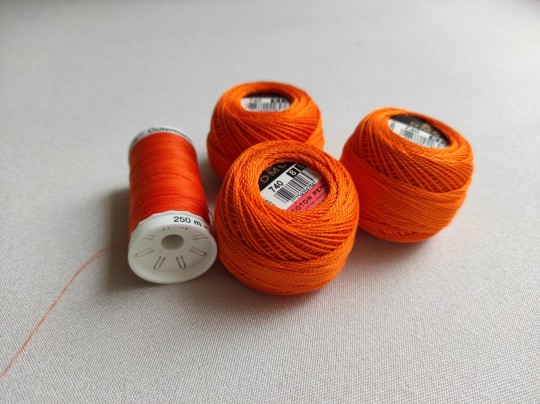
18 notes
·
View notes
Text
One-Tube “Push-Pull” Shortwave Receiver, in the June 1941 issue of Popular Science, readers were introduced to a compact radio project—a one-tube receiver that could cover long wave, medium wave, and shortwave bands.
This simple set relied on a single 1E7G dual-pentode tube, ingeniously wired as a push-pull detector. To tune across the different bands, the design required two plug-in coils per band, making it a flexible option for experimenters of the day.
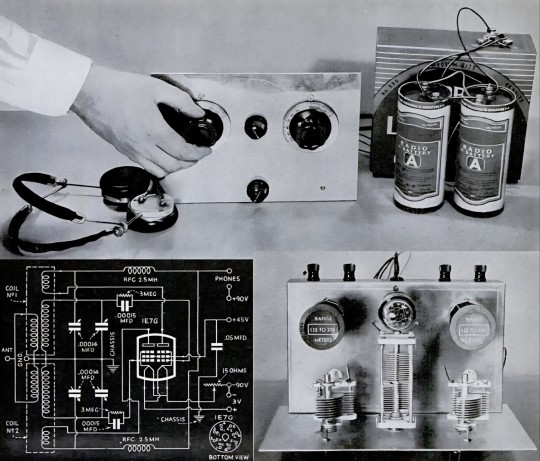
1 note
·
View note
Text
3.5 triodes specced out 2.5 more and a pentode to go
#cant finish the last triode until the one before its done etc all the way to the beginning but ive got a decent ballpark estimate#idk if specced out is the right term but ive got likely operating points and ac small sig behavior plotted
0 notes
Text
Why 5960-00-134-5995 is Essential for Military and Aerospace Systems
In military, aerospace, and marine industries, the demand for reliable, high-performance components is critical. The 5960-00-134-5995 electron tube is a trusted component known for its durability and operational excellence in mission-critical environments. This blog delves into its specifications, applications, and why sourcing it from reputable suppliers like ChipsonSale guarantees project success.
Specifications: The 5960-00-134-5995 is a beam power pentode electron tube, constructed with a durable glass envelope. It is cataloged under National Stock Number (NSN) 5960-00-134-5995 and manufactured to meet stringent military standards. This electron tube provides stable amplification and is designed to withstand extreme environmental conditions such as high temperature, vibration, and electromagnetic interference.
Applications: This component is widely used in radar systems, communication devices, and other critical aerospace and military equipment. Its reliability ensures that complex systems maintain optimal performance during demanding operations, where failure is not an option. The 5960-00-134-5995’s robust design makes it an indispensable part of mission-critical technologies.
Why Choose ChipsonSale? ChipsonSale offers a reliable platform for procuring the 5960-00-134-5995 and other essential components. Their extensive inventory, authentic parts, detailed product information, and streamlined purchasing process simplify procurement for engineers and procurement professionals. ChipsonSale’s commitment to quality and service makes it the go-to supplier for military and aerospace parts.
Conclusion: The 5960-00-134-5995 electron tube stands out as a key component for ensuring system reliability in mission-critical environments. Partnering with ChipsonSale guarantees access to high-quality components that meet exacting standards, helping you maintain the integrity and success of your projects. For more information and to place your order, visit ChipsonSale
#chipsonsale#highqualitycomponents#durablecomponents#reliableperformance#longlastingparts#reliableparts#trustedcomponents#electricalsystems#efficientfunctionality#electrontube
0 notes
Text
Completed the all tube 6CM6 guitar amp, and it is ready for a home.
0 notes
Photo
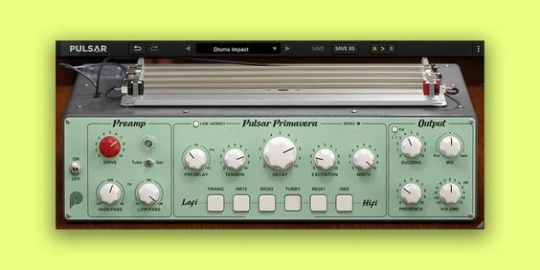
Timeless Organic and Vintage Reverb Spring reverbs are highly sought-after vintage audio equipment, but their rarity and high cost can make them inaccessible to many. Known for their unique, warm, characterful and organic tone, these reverbs have forged a sonic identity that spanned from the ‘50s to the ‘70s, and is back in vogue today. Pulsar Primavera is a 6-in-1 reverberation plugin that includes devices heard on countless hits throughout the ages. From lo-fi to hi-fi, each tank precisely emulates the original units' electronic and mechanical behavior. Furthermore, exclusive spring tension and excitation controls offer a wider sound palette than typical convolution models. The software is a complete reverb chain plugin with integrated saturation, filters, presence, and ducking controls. Get the signature “twang” tone that shaped music history, packed with next-gen features and a user-friendly interface. Realistic Spring Reverb Emulation Most digital spring reverbs sound flat and are poorly configurable because they sample real units rather than modeling them. With real-time physical modeling, Pulsar Primavera breaks free from these limits and allows manipulation of physical reverberation parameters, like spring tension or excitation, for unique and creative sound design possibilities. Hit and Shake the Springs! The ringing behavior of the springs can be influenced either by hand or via modulation (and automation), and used as a creative sound design effect. More than just a fun and interactive way to play with reverb springs, this feature allows the potential for some really interesting effects. A Complete and Versatile Reverb Chain Tension, Excitation: The Tension knob changes the reverb's character by adjusting the physical model of spring tension. Stretch them more or less to get a "softer" or a more "high-pitched" characteristic. The Excitation knob dynamically triggers the well-known sound of exploding springs, adding a creative touch to your sound design. It simulates subtle strikes on the springs as the instrument attacks pass through the plugin. Ducking, Presence (Output): The Ducking control allows you to create dense and prominent reverbs that never conflict with other elements in your song. This knob reduces the level of reverberation based on the input volume of the plugin (or the sidechain input), clarifying the overall signal when the audio kicks in and preserving space between musical phrases. Furthermore, they added a Presence tonal control that boosts a specific frequency range carefully chosen to make the reverb stand out in the mix. Decay, Width, Predelay: The Predelay and Decay knobs offer precise temporal adjustments to the reverb effect. Predelay enhances clarity with a delay before reverb is applied, and Decay tailors reverberation length for varied musical scenarios. The Width control allows you to adjust the reverb's stereo image. Drive, Tube, EQ (Preamp): Easily blend or sculpt the reverb to your taste with the built-in EQ filters. Adjust the presence of the tube circuits responsible for a pronounced high-frequency saturated sound with the Drive knob. You can also switch between two saturation modes if you want to add some grit to the reverb tail – Germanium corresponds to the transistor preamplifier of a well-known reverb used in dub music, and Tube to a warm pentode-type tube amplification. 6 Signature Spring Tanks Great British Spring: Produces a very dense and open sound. This is the cleanest reverb in the plugin’s selection, and is ideal for vocals and other elements that need to shine above the mix. HR12: A very lo-fi type of reverb built in Japan in the late '60s. Perfect for those who seek a vintage color, and the characteristic “boing” sound of the springs. Simple, dirty, and effective, this tank has very little low-end, which means that the initial attack of the springs is clearly heard, giving it that special lo-fi flavor. SR202: Built on a legendary hi-fi consumer reverb, this tank sounds dark, with prominent beats in the reverb tail. It’s the least dense reverb of their selection, with a vibey “flutter” color, perfect for adding realism to a source. RE201: Based on the classic Echo RE201 from Roland, this tank is maybe the most versatile compared to the other choices. With dense and diffuse reverberation tails, it can adapt to any source in any genre. It’s well suited on a lead vocal if you’re looking for some added excitement and color. Tubby: If you're looking for the color of old-school dub music, this tank gives you a very round and watery sound, with big beats. Great for adding subtle variations to your tracks by sending some sources into a bus with this reverb on it. A nostalgic effect that works really well on brass, skank keys, or guitars. Twang: For this tank, they took our inspiration from the guitar amps that popularized spring reverbs. Widely used in Fender and other classic instrument amplifiers, this reverb gives you the lo-fi sound that you’d expect from vintage gear, with tons of character and color. Diverse Presets, Artist-designed Pulsar Primavera comes with hundreds of presets for a solid starting point or quick inspiration. Apply polish and invention to your sounds with presets meticulously crafted by producers and mixing engineers. With so much choice at your disposal, they highly encourage some careful digging to find the right sonic treasure within. How Does it Sound? Drums: You've likely heard many recordings with spring reverb on snares, particularly in reggae and dub music. This effect later influenced rock bands, leading to springy snares being used in various styles. You can use Primavera’s predelay to knock down the transient and tame the sound if you want softer results. Beautiful drum-type sounds can also be made by kicking the springs! Pair it with delay, gate envelope, and other effects to achieve a unique sound design. Vocal: The deep, metallic timbre of spring reverb brings a raw edge to the sound. As a result it's a popular choice among rock bands for adding grit to vocal tracks. Additionally, using a spring reverb on the vocal is a wise choice when you need to place it in a separate space than the other elements in your arrangement. Guitar: For those seeking the timeless vintage electric guitar sound, Primavera is the ideal choice. Spring reverbs play a significant role in achieving a realistic guitar tone, and their plugin could be the missing link, or another possible color, in the perfect guitar sound you're after. Synths: If you're a Moog fan (or of any synth in this genre), spring reverbs can be an instant vintage preset that will quickly reinvent and add texture to your tracks. On VST synths Primavera introduces a subtle and natural grit for a more organic vibe. Features Drive and Saturation Mode: Adjust the level of saturation applied by the input preamplifier with the Drive knob. The Tube/Ger selector allows you to choose the preamplification circuit used before the reverb; a pentode-type tube amplification, or a Germanium transistor preamplifier. Uniquely, this saturation is also applied to the Dry sound. Tension: The Tension parameter alters the tension of the simulated springs to change the reverb’s character. Increasing tension stiffens springs, and this speeds up beats in the reverb tail, emphasizing high frequencies. Conversely, low Tension softens the feel, slowing beats and emphasizing bass frequencies in the reverberated sound. Excitation: The Excitation knob allows you to simulate springs shaking, similar to when clicked on with the mouse, but this time automatically. When this feature is activated, the springs are shaken in response to the transients in the input sound. This enhances the characteristic "boing" effect of the spring reverb, and enables creative sound design effects. Ducking: For those who are familiar with the kick/bass sidechain technique that is carried out with a compressor, the Ducking knob applies the same concept. It controls a compressor that reduces the reverb level when the instrument or voice passes through the reverb to clarify your mix easily. Vibrating Springs: You can get the characteristic "boing" sound of spring reverbs by “kicking” the springs with a mouse click, resulting in unique textures and sound design options. This feature perfectly captures the spirit of spring reverb units, allowing you to play with the device and find inspiration in a fun and rewarding way. Predelay and Decay: You can control the length of the reverb tail, short or long, by using the Decay knob. Or adjust the delay between the original signal and the start of the reverberated sound with Predelay. Higher values on the Predelay knob provide better separation between the direct sound and the reverberated sound. Width: Pulsar Primavera comes with a Width knob to let you control the stereo image of the reverb. A setting of zero will make the reverb mono, while a value of 10 corresponds to the maximum stereo width of the selected springs tank. Controlling width can help to keep things sound realistic and more "intact", according to the instrument the effect is applied to. Presence: This knob creates a slight emphasis on the upper mids of your reverberated signal, enhancing the reverb's presence in the mix. Keep the original signal unchanged, or push the treble to make the reverberation tone cut through the other elements in your track and become more audible. External Sidechain: The Ducking can optionally be set to use an external sidechain signal. In this case, another audio track must be routed to the plugin sidechain input in your DAW, and that track will be used to calculate the ducking of the reverb. One possible use for this is to make a guitar's reverb more subtle when a synthesizer is also playing, freeing up space. Filters: A choice of built-in 12dB/octave High-pass and Low-pass filters are also available to clean up your source before sending it into the reverb. These filters are processed just after
0 notes
Text

(http://www.op316.com/tubes/myamp/6f603.htm)
SRPP回路応用編「ハイゲイン・ローインピーダンス回路」(SRPPレポートその2)です。同種の3極管を上下に2本重ねたおなじみのSRPP回路では、利得は3極管そのままに、出力インピーダンスを低くできることはみなさんもよくご存知だと思います。これを、5極管と3極管を上下に重ねてみたら、利得は5極管並になって、出力インピーダンスはSRPPらしく低くならないだろうか、と考えたわけです。もしかしたら、利得は3極管、出力インピーダンスは5極管なんていう失敗作になってしまうかもしれませんが。
ところが、思惑は大当たりで、5極管(またはFET)の上に3極管を乗せた応用SRPP回路では、容易に高い利得と低い出力インピーダンスが得られ、最大出力特性もすぐれていました。この回路は、私が宣伝していることもあって、ニフティサーブのFJAZZフォーラムでもっぱら「ぺるけドライブ(私のハンドルネームをぺるけといいます)」と呼ばれています(図)。
5極+3極SRPPドライブ(ぺるけドライブ)6F6GT全段差動ppアンプ
Pentode & Triode SRPP Drived 6F6/6V6/6L6-pp All Stage Diffential Amplifier
3.どんなアンプにするか
by ぺるけさん
0 notes
Text
anyway i think the omen 6 sounds better than i remember... maybe it's just cause pentode and the rat. the thing was always toooooo bright so i guess the rat is really helping with that. oh. maybe i havent played this since i got the marshall??
0 notes
Text
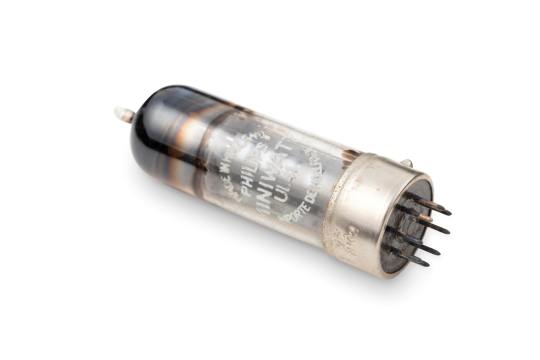
PHILIPS 'MINIWATT' TYPE UL41 ELECTRONIC VALVE
Electronic valve, 'Miniwatt', type UL41, remote cut off pentode, glass / metal, made by Philips, Holland, 1945
19 notes
·
View notes
Text
Simple DIY tube guitar amplifier
Vacuum tube technology always means bulky, heavy cases, dangerously high voltages, and complex multi-channel power supplies. Or does it?
This little amplifier is powered by a 12V wall-wart AC/AC transformer adapter. Its anode voltage is only 56 volts. It's high time to learn how this voltage is created from 12V and how a simple tube amp actually works.
We will also see on the oscilloscope screen that that unique tube sound signature is loved by audiophiles and musicians, especially guitarists. And then, we'll talk about the difference between long and short vacuum tubes.
The amplifier uses two 6BA6 pentodes. One can also use 6BD6, European EF93, and Chinese 6K4. In today's experiment, I specifically used 6K4s because they are inexpensive and easy to get.
Instead of pentodes with long characteristics and long bodies, one can use short ones like 6AK5, EF95, 6J1, and 6J2. They will also sound great but in a different way.
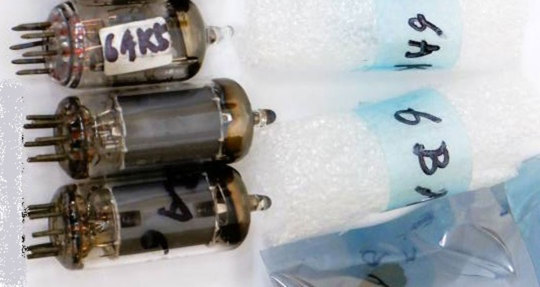
To understand the difference between a remote (long) cutoff and a sharp (short) cutoff of a vacuum tube, let’s check the principles of their operation.
The simplest vacuum tube is called a diode because it has two electrodes: a negative cathode and a positive anode. They are both contained in a glass or metal container with air pumped out of it so that its molecules do not interfere with the movement of electrons.
The silverish substance at the top of the flask is a gas absorber. It removes residual gas particles from the lamp that haven't been pumped out during the manufacturing process or those released due to heating.
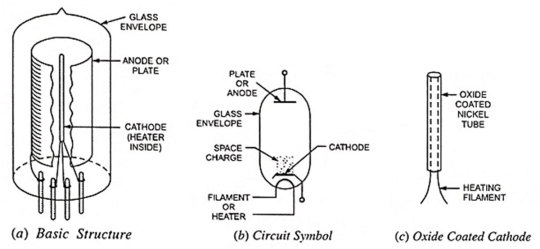
The cathode is usually a nickel straw coated with barium or strontium oxide. The oxide coating is necessary to enhance electron emission.
Inside the tube, there is a heater—a tungsten spiral, like in an incandescent light bulb. The spiral is electrically isolated from the tube, which allows several tube heaters to be powered by a single source of current. The cathodes of those tubes can have different voltages and different signals at the same time.
The most common tubes are designed for heater voltages of 6.3 and 12.6 volts. The model numbers of American and Chinese tubes, unlike European ones, begin with one or two digits of the filament voltage. For example, 12AX7, 6BA6, and today's 6K4.
There are also directly heated cathodes, which are just tungsten spirals. They are typically used in battery-powered tubes. For example, 1N34, 2L34, and their Chinese analogs 1A2 and 2P2. This cathode is easier to heat and keep heated, which saves battery life.
The anode is usually a metal box covering the cathode. The anodes of low-power tubes are made of nickel or iron, and those of high-power ones are made of molybdenum, tantalum, or graphite, as they can withstand higher temperatures.
The surface of the anode is often made black and ribbed to radiate heat efficiently. The tube's electrode cannot transfer heat through convection because no air is around it.
The thermal conductivity of the electrode standoffs that complete the electrical loop to the output terminals is tiny. So, the only way to transfer heat from the inner parts to the outside environment is through thermal radiation.
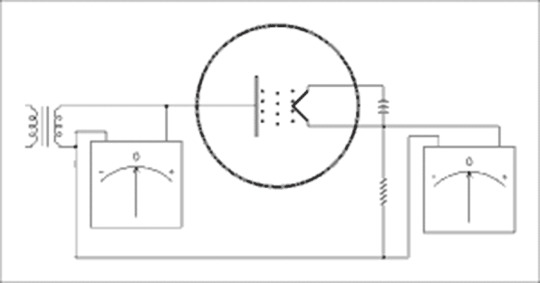
The heated cathode emits electrons, and a cloud of electrons forming around it is called space charge. Like charges repel, space charge prevents further emission of electrons from the cathode.
Suppose the anode has negative or zero potential relative to the cathode. In that case, nothing happens, and the current won't flow through the tube from the cathode to the anode. But, the positive potential of the anode attracts electrons. They will fly towards the anode, and the current will flow.
Thus, a vacuum diode allows current to flow in only one direction—from the anode to the cathode. After all, the direction of the current is always indicated by an arrow from plus to minus; this direction is for the movement of imaginary positive charges.
In P-type semiconductors, charge carriers are indeed positive; in electrolytes, both positive and negative; and in metal wires and vacuum tubes, negative electrons.
So, a vacuum diode can be used for rectifying AC current (then the tube is called a kenotron), detecting an amplitude-modulated radio signal, and for many other purposes where current needs to be passed in only one direction.
Things get much more enjoyable when, between the cathode and anode, the mesh is added. Such a tube with three different electrodes is called a triode.
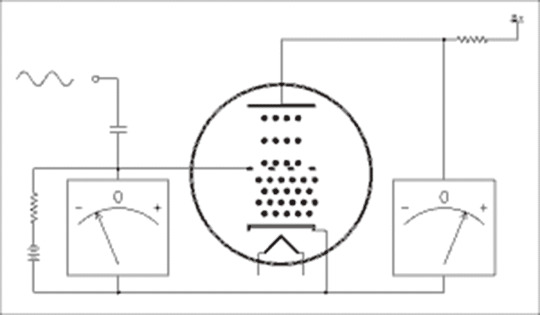
When the mesh is negatively charged relative to the cathode, it repels electrons. It makes it harder for them to reach the anode until the flow is completely blocked.
When the mesh's potential is positive relative to the cathode, it attracts electrons from the cathode. Some electrons are captured by the mesh wires and never reach the anode. They create a grid current, a very small one because the wires are thin and the gaps between them are huge.
Therefore, most of the electrons attracted from the cathode and accelerated by the positive potential of the mesh fly right through it and reach the anode. The anode current is much greater than the mesh current.
However, any tube circuitry must have a so-called grid leak, an electrical loop, usually just a resistor between the mesh and the cathode, ensuring the return of electrons from the grid to the cathode. Otherwise, electrons will accumulate on the insulated mesh, and a significant negative potential will occur, which will block the lamp.
So, a vacuum triode is a device that controls the anode current by changing the grid voltage. Suppose a resistance is included in the anode or cathode circuit. In that case, the voltage drop across it will correspond to the anode (or cathode) current according to Ohm’s law.
Thus, we get an amplification of voltage, current, and power. A small change in grid voltage with a tiny grid current controls significant changes in output voltage and current.
This way, one can amplify the signal from a microphone, the pickup of a vinyl record player or guitar, radio waves from an antenna, and so on. And if a transformer with a loudspeaker is connected to the anode circuit, we get a loud-speaking sound amplifier.
The usual mesh of a regular "short" tube has an equal distance between the wires. Or should we say coils because the wires are actually coils winded around the mesh posts.

The image shows how the negative potential of the grid shields the positive electric field of the anode, preventing it from attracting electrons from the cathode.
The mesh of the “long” tube is wound unevenly, with different distances between the turns. And this is not a sign of carelessness; it was done intentionally.
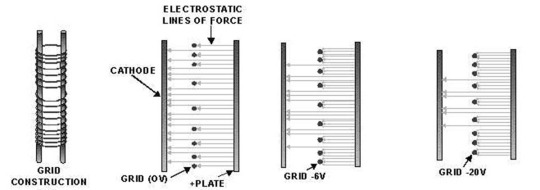
In those places where the distance between the wires is wider, the electric field of the anode does not immediately switch to the grid. Still, it continues to reach the cathode, attracting electrons. This allows for the extension of the characteristic of the tube, which is the main difference between a remote (long) cutoff and a sharp (short) cutoff.
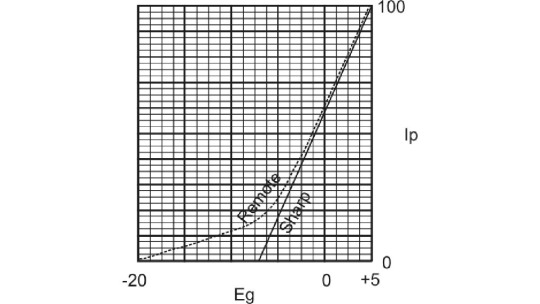
What is the nonlinear transfer characteristic of the tube needed for? Doesn't it distort the signal? And the answer is yes, it distorts, and when applied to guitar amplification and music reproduction, this helps to get interesting results.
However, remote cutoff tubes were originally intended for circuits with automatic gain control. The dependence of the amplification factor, or µ (Greek letter "mu"), on the grid bias voltage, allows one to make a voltage-controlled amplifier (VCA).
And suppose this offset is set by an amplitude envelope detector (like the one in VU-meters). In that case, we get greater amplification of the strong signal and less amplification of the weak one, that is, compression and stabilization of the signal level. This can be very useful and necessary in many cases.
So, let's get started with our amplifier. I took a popular tube buffer board for a home audio system as a base for my project; only a couple of modifications were needed. Here is the diagram for this board.
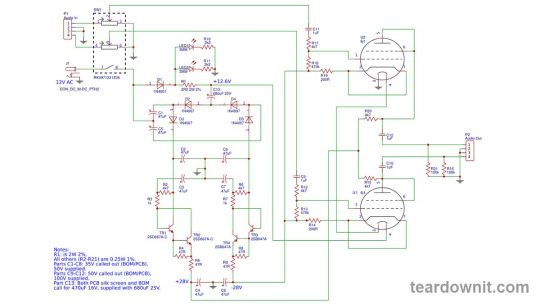
The amplifier consists of two identical stages. Pentodes here are used as triodes; the second mesh is connected to the anode. The tubes are connected according to a common-cathode circuit.
R13, R18—grid leak resistance. R14, R19—cathode bias resistances, providing a negative grid potential relative to the cathode. R15 and R20 are anode load resistors outputting the amplified signal.
The cathode heaters are connected in series since the supply voltage of the circuit is 12 volts alternating current, and the nominal filament voltage of each lamp is 6.3 volts, so the total is 12.6 volts.
In this scheme, the heaters are powered by a smoothed direct current. This is an ideal way to power them because it eliminates the possibility of AC mains hum remaining in the output signal.
The voltage for powering the heaters is provided by a half-wave rectifier D1 and a pulsation-smoothing RC filter R1 C13 after it.
The tubes are beautifully illuminated by blue LEDs (LED1 and LED2). Since LEDs cannot withstand reverse voltage, they are powered by direct current from the filament rectifier D1. R10 and R11 determine the LED current.
An anode supply of 56 volts is obtained using voltage quadruples consisting of two doublers: positive voltage +28V D2, D3, C1, C2, and negative voltage -28V D4, D5, C5, C6.
Two capacitance multipliers are assembled on capacitors C3 and C7 and transistors TR1 and TR3. Another name for such a circuit is an electronic choke.
The capacitance multiplier is an emitter follower with a capacitor at its input. At the output, the repeater will maintain a constant voltage smoothed by a capacitor.
Thus, the capacitance of the capacitor is multiplied by the transistor gain plus one, β + 1. The minimum gain of the 2SD667A-C and 2SB647A-C transistors is 100.
Thanks to the capacitance multiplier, we have the equivalent of filter capacitors with a capacity of over 4700 microfarads. This ensures almost perfect filtration of the anode power.
Current limiters are assembled on transistors TR2 and TR4. Suppose the voltage across the resistor R4, through which the anode current flows, reaches a value sufficient to open TR2. In that case, it opens and bypasses the base junction of TR1, closing it.
Current protection TR4 R8 works in precisely the same way. And resistors R5 and R9 form additional RC filters with capacitors C4 and C8.
To get a two-stage monophonic guitar amplifier from a single-stage stereo amplifier, connect the left channel output to the right channel volume control input.
Apply a sinusoidal signal with a frequency of 500–3000 Hz to the input of the amplifier, and you'll see a pure sine wave on the oscilloscope screen.
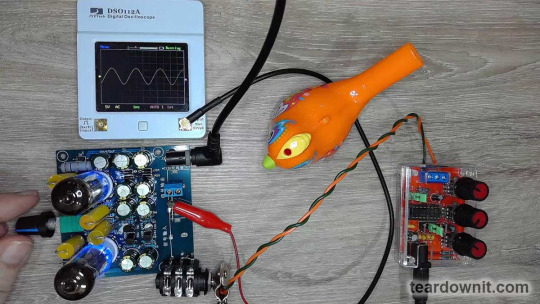
Increasing the signal level, we widen the upper half-wave and narrow the lower half-wave.
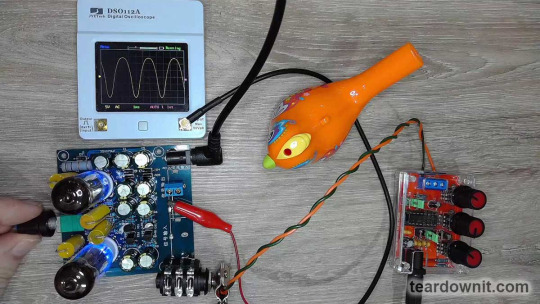
This waveform is characteristic of the sum of a sine signal with its second harmonic, the same sinusoid, but with double the frequency and half the amplitude.
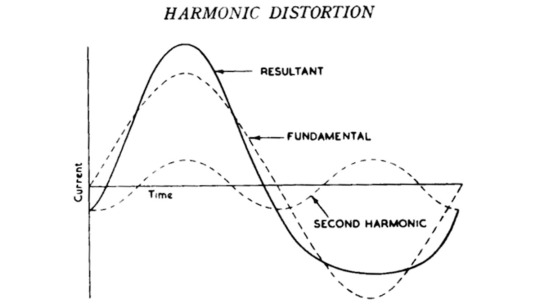
These even harmonics are the secret to the beauty of the tube sound that we adore so much. They can be obtained without a tube by digital or analog simulation. Still, in tube stages, they arise naturally with no trickery.
The amplifier board was originally intended to act as a buffer between components in a home stereo system. That is, to match the high output impedance of a signal source (for example, a player) with the low input impedance of a receiver (for example, an amplifier).
It also eliminates the influence of connecting cables. It slightly enriches the signal with tube harmonics, which add crispness and beauty to the sound of individual instruments in a composition. High gain is not required from such a tube buffer; the signal level at both the input and output is linear.
I will use the amplifier as a guitar one, so I'll solder a couple of 100 uF 16V capacitors in parallel with the cathode resistors R14 and R19, positive terminals to the cathode of the lamp.
This will ground the cathodes for AC without changing the DC bias. The gain of the amplifier will increase.
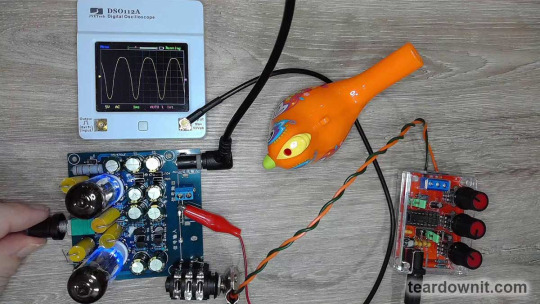
Now, when the volume control knob comes close to the right-most position, the upper half-wave acquires a flat top with no sharp bends, indicating a soft tube limitation.
The tube preamp is ready for testing. As a power amplifier, we will use a board based on the TDA2030 chip in standard configuration as an electronic load with Cabsim, Torpedo Captor X.
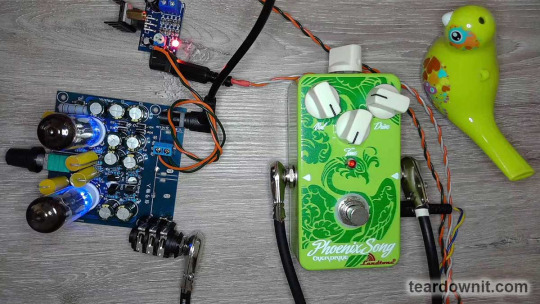
Connecting the Squier Bullet Mustang HH guitar directly to the amplifier, as well as through a homemade Landtone Phoenix Song Overdrive pedal (we have a separate post on it),
youtube
Connecting the Squier Bullet Mustang HH guitar directly to the amplifier, as well as through a homemade Landtone Phoenix Song Overdrive pedal (we have a separate post on it),
youtube
The first sound test of this small amplifier made me smile. It has an unexpectedly pleasant, clean sound and a nice light overdrive. Higain, of course, will require additional equalization and power amp simulation.
I will get my hands on sharp cutoff pentodes in the upcoming future and compare their sound as well as the oscillograms of sinusoidal signal processing.
Thank you for your time!
1 note
·
View note
Text
Up here on the high end.
Back when I was young, the term for good audio was high fidelity, Hi Fi for short. That is a good term, it captures the idea of accurate reproduction of a recording. That was usually music, but for a while there was a niche of sound effects like steam trains. Chug, chug, Chug. That is where Mobile Fidelity,now known as MOFI, got its start.
Then publishers of magazines (real printed on paper things) needed to distinguish themselves as one magazine was named "High Fidelity" and copyrights must be respected. So the term "High End" was created to capture "better stuff" and avoid the name of that other magazine. Several mags shared the term, as I do not recall any grabbing the name as their title.
Included in this idea was the character of the Audiophile. They were a type of person, and the target audience of these publications. Back in this era there was no online anything, so you had to actually print and distribute real physical things with printed words and pictures. The audiophile was a sophisticated, wise and charming person, and a man of course (sorry the 60s & 70s were a dark age). Old ads for stereos often had lovely young women sitting demurely on the shag carpet flipping through LPs while the audiophile mixed martinis from the drinks cabinet. Some ads went as far as soft core porn.
This was when men had to compete with slick haired rockers in hot rods. What to do if you did not know, what headers were, how to fix a carburetor, or tune a spark advance curve with a file. Get a stereo!
The term audiophile has a specific meaning, almost technical, of a person who loves sound. It does not denote anything to do with wealth, or foolish spending. That comes later.
I consider myself to be an audiophile without the foolish spending bit (or wealth). I am also a geek (an old one to be sure). I enjoy technical challenges and want to know why and how something works. And I love to listen for tiny details in music recordings. I love the visceral impact of heavy Bass. (Literally visceral!) I love the almost hallucinogenic dreamscape that can be created by the best recordings.
I consider my system to be high end. By that I mean it can find and extract information off of plastic disks with wiggly grooves, or digital dots and play them across my room. I get all of it off the source and most of it into the room. I have superior equipment, and I know how to use it.
It has limits of course, and nothing is perfect.
I also know how to avoid nonsense and fraudulent products. If they cannot explain how it works it is likely a con job. If they advertise real physical things that effect microwaves as working in speaker wires I know they are lying.
It is true that many people cannot distinguish between different and better. They may try something like a new phono pickup and hear something they had not heard before. Oooh that must be better! The idea of a slightly different frequency response is too technical.
So they chase the rabbit all over the field always getting different, but mistaking it for better. Good for business as it sells gear.
I hope that my skepticism and technical background protect me from too many chases. But I am curious. I also have preferences.
A couple years ago I bought a relatively expensive tube amplifier of high pedigree for two reasons. I do like the voice of tubes when done with restraint. I also recognized good value and was willing to risk the age versus condition problem. Most tube amplifiers do not sound good to me. They are soft and fuzzy, and often have poor frequency response. There are very few people who can design tube amps properly. The Tube Guru says nobody can design front ends with pentodes anymore. If they are out there they are copies of units designed in the 1950s.
When a tube amp sounds right it is a joy. It is music. They have limits, subtle limits, but real ones. I hear when it runs out of power. Only transistor amps can push amps hard enough. I hear when it masks a sound.
(Aside here. Amps can refer to Amperes which is a measure of electrical current and is physically the number of electrons being pushed through a wire. It is also a convenient term to use for Amplifiers that have the job of making tiny electrical signals not tiny.)
I am buying another amplifier which has a pedigree. My main unit is a mongrel where I took a basically good design and fiddled it with a few trick ideas and parts. Yet he is a mongrel. Only my ear tells me it is high end. It sounds different than my tube amp and reveals sounds the tuber hides. In amplifiers it really can't be a frequency response problem, so I think it is very subtle masking from distortion products.
This new beast is different and comes from a different design philosophy of a different audio demigod. I expect tiny differences. I also hope it will confirm what my ear tells me of the quality of my mongrel. In dogs mongrels (or mixed breeds) are often better and more healthy that purebreds as there has been less messing about with the basic animal constitution, or at least the mixture alleviates some of the mistakes by dilution of the breeder messing about.
I electronics it is pushing an idea a bit too far, or giving it more credit than is due for it's differences.
Further I believe that newer ideas are pushed only because they are new. I have serious doubts about Class D amps as almost all come from a limited number of subcontractors with an even more limited number of integrated circuit factories. Different boxes with the same guts. I have looked at buying some of these guts, they are available to the public, and I cannot believe that such tiny wires can drive the Watts they claim to. Old School for this old guy.
High end man its really cool.
1 note
·
View note
Text
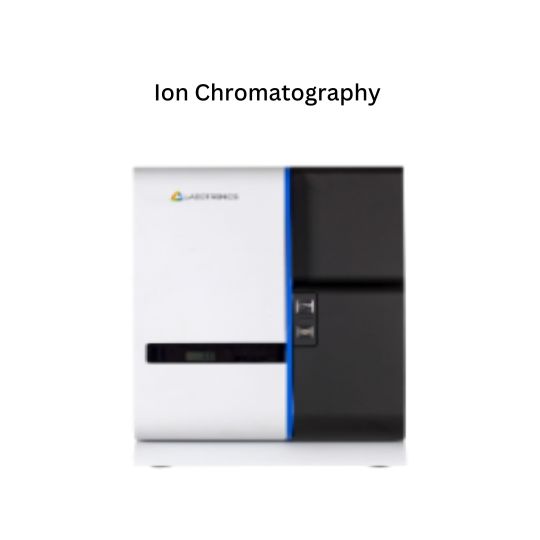
Ion Chromatography
Ion Chromatography LB-11ICG unit is a chromatography system used for high precision cation and anion analysis. It is incorporated with PEEK (Polyether ether ketone) flow path system, ensuring chemical resistant at high temperature. Features pentode or bipolar circuit conductivity for identification and measurement of analytes. Built in single channel and double channel detection mode for efficient separation.
0 notes